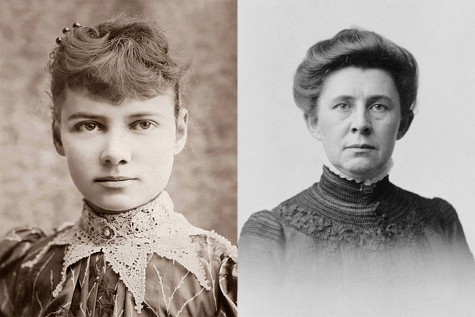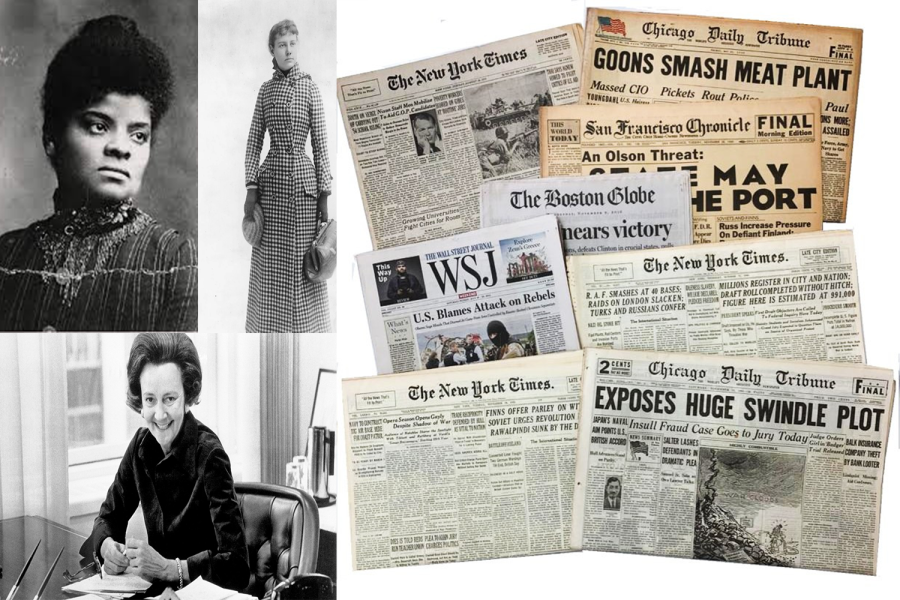Women in journalism who incited social change
Ms. Ida B. Wells, Mrs. Katharine Graham, and Ms. Nellie Bly break gender barriers in the newsroom.
Although newspapers have existed since the seventeenth century, women only entered the field in the late nineteenth century, according to newworldencyclopedia.org. Today, women only hold thirty-six percent of all journalist positions, according to pbs.org. In a male-dominated field, reporters such as Nellie Bly, Ms. Ida M. Tarbell, Ms. Ida B. Wells, Ms. Clare Hollingworth, Ms. Gloria Steinem, and Mrs. Katharine Graham have paved the way for female journalists by breaking gender barriers. Sacred Heart Greenwich alumna Ms. Caroline Kitchener ’10, national political reporter at The Washington Post, faces the challenge of working in a predominantly male workspace today.
In 1887, Mrs. Elizabeth Cochran Seaman, known under the pen name Nellie Bly, triggered an age of investigative journalism by going undercover inside Blackwell Island and exposing the horrors inside the mental health asylum, according to womenshistory.org. As one of the first female reporters, Bly broke gender stereotypes by writing for New York World and using her voice to create social reform. Bly became a “muckraker,” a journalist who uncovers corruption and scandal to create reform. She reported on the conditions inside asylums, large industrial factories, and the abuse of women by police officers. Her articles inspired many Americans to take action against social inequalities, and her pioneering work paved the way for future female journalists, according to wams.nyhistory.org.

In the age of muckraking journalism, Ms. Tarbell revealed the atrocities inside Mr. John Rockefeller’s Standard Oil Company. Her work led to the 1911 Supreme Court decision that found Mr. Rockefeller’s company guilty of breaking the Sherman Antitrust Act, ultimately splitting his company into 34 pieces, according to connecticuthistory.org. The effects of Ms. Tarbell’s articles showcase the power of the pen and her everlasting legacy in journalism, establishing her as a role model for females pursuing journalism, according to womenofthehall.org.
Ms. Wells also used the power of journalism to create social change. In 1886, she became the first female co-owner of the Black newspaper The Memphis Free Speech and Headlight. After a friend of hers became a victim of a lynching, Ms. Wells used her position in the newspaper to write editorials about anti-lynching, focusing her articles on the false accusations that led to lynching. Through journalism, Ms. Wells sought to spread awareness of the horrors of lynching and end deaths from lynching in the United States (US), according to wams.nyhistory.org.
In 1939, Ms. Hollingworth witnessed and reported on Germany’s invasion of Poland, an article that made headlines. Throughout her career, Ms. Hollingworth wrote pieces for The Telegraph, The Guardian, The International Herald Tribune, and The Wall Street Journal. Through her undercover reporting of mainstream events, Ms. Hollingworth became a role model for females pursuing journalism, as she created a name for herself in a male-dominated field, according to The New York Times.
Although Ms. Steinem eventually became an acclaimed women’s rights activist and journalist, at the start of her career, she found it difficult for others in the field to take her seriously. In response to these struggles, Ms. Steinem helped found both New York Magazine and Ms Magazine, giving her a platform to amplify social issues. Through journalism, Ms. Steinem argued for women’s rights and received the Presidential Medal of Freedom in 2013 due to her work, according to womenshistory.org.
Mrs. Graham became one of the first female publishers in America and the first-ever leader of a Fortune 500 company as the chief executive officer (CEO) of The Washington Post. Through her position, Mrs. Graham defied the US government by publishing the Pentagon Papers, exposing the US Executive Office’s involvement in the Vietnam War and reporting on the Watergate scandal. Though she held a leadership position, she faced sexism daily as women remained a minority in the newsroom throughout the 1960s and 1970s. Nevertheless, Mrs. Graham opened the way for more women to hold high-ranked positions, breaking the wall of patriarchy, according to washingtonpost.com.

Ms. Kitchener is a national political reporter for The Washington Post and has previously written for The Atlantic, The Guardian, The Lily, Vox, and The Washington Post. She graduated from Sacred Heart in 2010 and studied at Princeton University, according to washingtonpost.com. Even though today women only hold thirty-six percent of the positions in the newsroom, because of women like Nellie Bly, Ms. Tarbell, Ms. Wells, Ms. Hollingworth, Ms. Steinem, and Mrs. Graham, women are able to hold positions of power in journalism and report about domestic and global matters, according to pbs.org.
Featured Image by Emily Shull ’25

Emily is incredibly grateful to serve as the 2024-2025 Editor-in-Chief of the King Street Chronicle. After two years on the newspaper’s staff, Emily...


